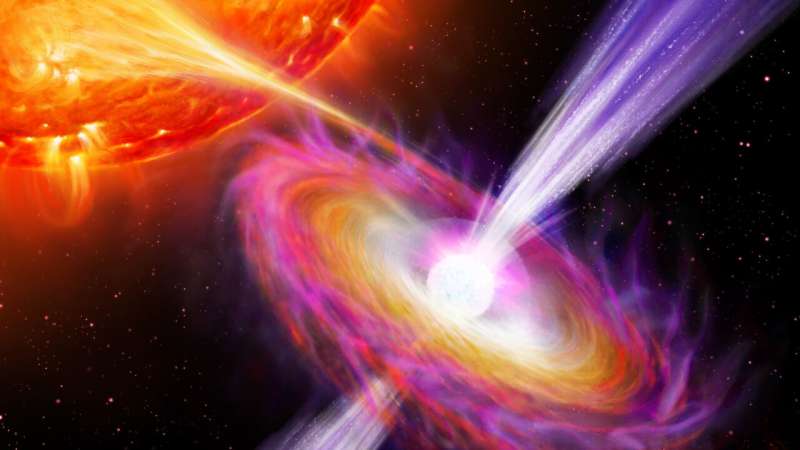This article has been reviewed according to Science X's editorial process and policies. Editors have highlighted the following attributes while ensuring the content's credibility:
fact-checked
peer-reviewed publication
trusted source
proofread
'Cosmic cannibals' expel jets into space at 40% speed of light

For the first time, astronomers have measured the speed of fast-moving jets in space, crucial to star formation and the distribution of elements needed for life.
The jets of matter, expelled by stars deemed 'cosmic cannibals', were measured to travel at over one-third of the speed of light—thanks to a groundbreaking new experiment published in Nature today.
The study sheds new light on these violent processes, making clever use of runaway nuclear explosions on the surface of stars.
Co-Author Jakob van den Eijnden, Warwick Prize Fellow at the Department of Physics, University of Warwick, said, "The explosions occurred on neutron stars, which are incredibly dense and notorious for the enormous gravitational pull that makes them swallow gas from their surroundings—a gravitational pull that is only surpassed by black holes.
"The material, mostly hydrogen from a nearby star that orbits around, swirls towards the collapsed star, falling like snow across its surface. As more and more material rains down, the gravitational field compresses it until a runaway nuclear explosion is initiated. This explosion impacts the jets that are also shot out from the infalling material and eject particles into space at very high speed."
The team devised a way of measuring the speed and properties of the jets by comparing X-ray and radio signals picked up by the Australia Telescope Compact Array (owned and operated by CSIRO, Australia's national science agency) and the European Space Agency's (ESA's) Integral satellite.
Co-Author Thomas Russell, National Institute for Astrophysics, INAF, Palermo, Italy, said, "This gave us a perfect experiment. We had a very brief short-lived impulse of extra material that gets shot into the jet and that we can track as it moves down the jet to learn about its speed."
Jakob van den Eijnden added, "These explosions occur every couple of hours, but you can't predict exactly when they will happen. So you have to stare at the telescope observations for a long time and hope you catch a couple of bursts. Over three days of observations, we saw 10 explosions and jets lighting up."
The jets traveled around 114,000 kilometers per second, an incredible 35-40% of the speed of light.
This was the first time astronomers had been able to anticipate and directly watch how a certain amount of gas got channeled into a jet and accelerated into space.
Co-Author Nathalie Degenaar, University of Amsterdam, the Netherlands, continued, "Based on previous data, we thought the explosion would destroy the location where the jet was being launched. But we saw exactly the opposite: a strong input into the jet rather than a disruption."
The researchers believe the mass and rotation of neutron stars and black holes also impact the jets.
Having now shown this research is possible, this study will form the blueprint for future experiments into neutron stars and their jets. Jets can also be produced by cataclysmic events such as supernova explosions and gamma-ray bursts. The new results will have wide applicability in many studies of the cosmos.
More information: Thomas Russell, Thermonuclear explosions on neutron stars reveal the speed of their jets, Nature (2024). DOI: 10.1038/s41586-024-07133-5. www.nature.com/articles/s41586-024-07133-5
Journal information: Nature
Provided by University of Warwick




















